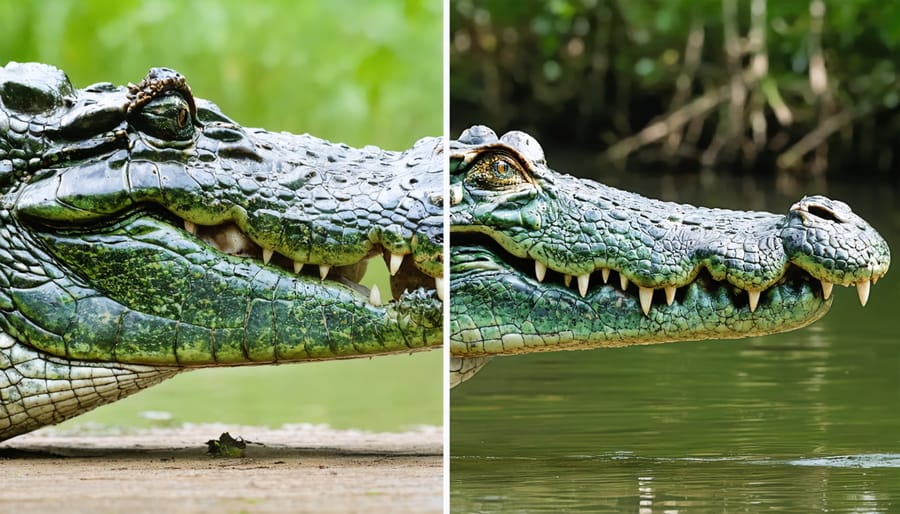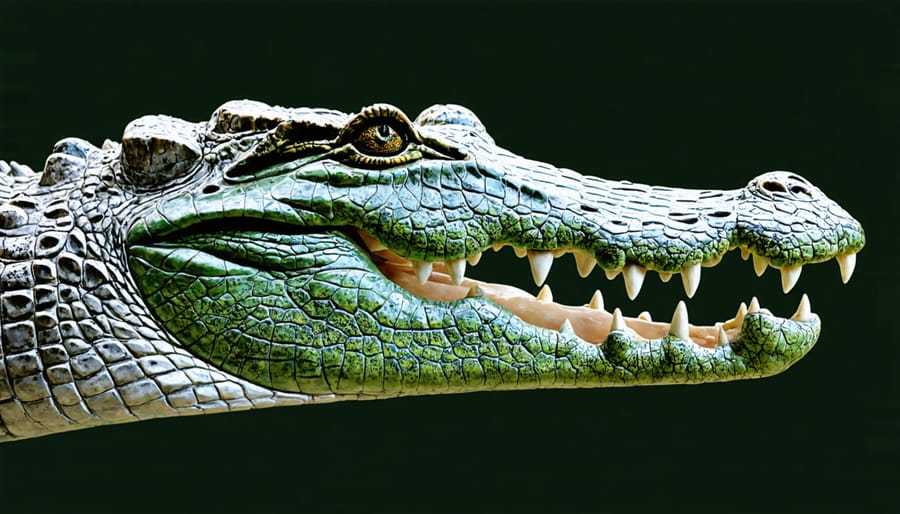Alligators vs Crocodiles: Which Fearsome Reptile Reigns Supreme?

Physical Differences
Snouts and Teeth
One of the most noticeable differences between alligators and crocodiles is the shape of their snouts. Alligators have wide, U-shaped snouts that are well-suited for crushing prey like turtles and shellfish. In contrast, crocodiles have longer, more pointed V-shaped snouts that are ideal for catching fish and other agile prey. Another distinguishing feature is that when an alligator closes its mouth, its teeth are hidden from view, giving it a less threatening appearance. Crocodiles, on the other hand, have teeth that protrude over their upper lip even when their mouths are shut, contributing to their more menacing look. These physical adaptations reflect the different ecological niches these reptiles occupy and the types of prey they specialize in hunting.
Word count: 123

Size and Color
While both alligators and crocodiles are large reptiles, crocodiles tend to be significantly bigger. The saltwater crocodile, the largest living crocodilian, can grow up to 23 feet long and weigh over 2,200 pounds. In contrast, the largest alligator species, the American alligator, typically reaches a maximum length of around 15 feet and weighs up to 1,000 pounds.
Coloration is another distinguishing factor between the two. Crocodiles generally have lighter, olive-green to grayish-green skin, while alligators are darker, with blackish-gray to almost black coloring. The lighter hue of crocodiles helps them blend into their preferred river and coastal habitats, whereas the darker tone of alligators provides better camouflage in the murky, tannin-stained waters of swamps and marshes. These physical differences reflect the distinct ecological niches occupied by alligators and crocodiles.
Habitat and Behavior
Freshwater vs Saltwater
While both alligators and crocodiles are semi-aquatic reptiles, they have different habitat preferences. Alligators primarily inhabit freshwater environments such as swamps, marshes, rivers, and lakes in the southeastern United States. Their bodies are well-adapted to these habitats, with broad snouts and eyes positioned on top of their heads, allowing them to submerge their bodies while still being able to see and breathe.
In contrast, crocodiles have a higher tolerance for saltwater and can be found in coastal areas, estuaries, and even the open ocean. Their salt glands, located near their tongues, help them excrete excess salt from their bodies. This adaptation enables them to thrive in a wider range of aquatic environments compared to alligators. However, crocodiles also inhabit freshwater habitats, particularly in regions like the Everglades where they coexist with alligators. Understanding these habitat differences is crucial for accurately identifying and studying these powerful reptiles in their natural environments.
Aggression Levels
When it comes to aggression levels, crocodiles are generally considered more aggressive than alligators. Crocodiles’ higher aggression makes them more likely to actively pursue and attack humans, viewing them as potential prey. This predatory instinct, combined with their larger size and more powerful bite force, contributes to crocodiles being responsible for more human fatalities worldwide compared to alligators. In contrast, alligators tend to be more reclusive and less inclined to attack humans unless provoked or defending their territory. While both species can be dangerous, the likelihood of an unprovoked attack is significantly higher with crocodiles. It’s crucial for people living in or visiting areas inhabited by these reptiles to exercise caution and respect their habitat to minimize the risk of negative encounters.
Geographic Range
Alligators have a much more limited geographic range compared to crocodiles. Alligators are only found in parts of the US and China, primarily in the southeastern United States and the Yangtze River valley in China. In contrast, crocodiles have a wider distribution spanning many countries across Africa, Asia, Australia, and the Americas. They inhabit diverse habitats including freshwater wetlands, rivers, lakes, and even coastal areas. This broader range means humans are more likely to encounter crocodiles in the wild, potentially increasing the chances of dangerous interactions. Understanding the geographic differences between these reptiles is crucial for assessing relative risk and promoting coexistence.

Danger to Humans
Attack Frequency and Fatalities
According to wildlife attack data, crocodiles are responsible for far more frequent and fatal attacks on humans compared to alligators. The Nile crocodile alone, found throughout sub-Saharan Africa, is estimated to kill hundreds of people each year. Saltwater crocodiles, ranging from India to Australia, also have a fearsome reputation as man-eaters. In contrast, alligators are typically less aggressive towards humans and fatal encounters are quite rare, with an average of less than one per year in the U.S.
Several factors contribute to crocodiles’ higher danger level. Their larger average size, more muscular build, and stronger bite force make them physically more formidable. Behaviorally, crocodiles tend to be more territorial, quicker to aggression, and willing to actively pursue prey. Many crocodile species also share habitat with dense human populations, leading to more potential conflict. Alligators are usually more skittish towards humans and mainly attack in self-defense. While alligator bites can still be serious, victims have a much higher chance of escaping and surviving the encounter. So while both animals command respect, crocodiles are statistically the far greater threat. Knowing how to identify them and avoid risky waterways is key to minimizing danger in their habitats.
Reasons for Attacks
While both alligators and crocodiles can be dangerous, crocodiles are generally considered a greater threat to humans due to several key factors. First, crocodiles have a much wider geographic distribution than alligators, inhabiting regions across Africa, Asia, Australia, and the Americas. This broader range means that crocodiles more frequently share habitats with human populations, increasing the likelihood of encounters and potential conflicts.
Moreover, crocodiles tend to occupy a greater variety of habitats compared to alligators, including freshwater rivers, lakes, and wetlands, as well as coastal areas and even the open ocean. This adaptability allows crocodiles to thrive in close proximity to human settlements and activities, such as fishing and recreation, further elevating the risk of negative interactions.
Perhaps most importantly, crocodiles are known to exhibit more aggressive behavior than alligators. While both species will defend their territories and young, crocodiles have a stronger predatory instinct and are more likely to actively pursue and attack humans who enter their habitat. This heightened aggression, combined with their larger average size and more powerful bite force, makes crocodiles a formidable threat to human safety in regions where they are present.
Conclusion
While both alligators and crocodiles are formidable predators that demand respect, crocodiles pose a greater danger to humans overall. Crocodiles’ more aggressive nature, larger size, and powerful bite force make them a more significant threat in regions where they come into contact with people. Their adaptability to saltwater also means a greater chance of human encounters compared to alligators, which primarily inhabit freshwater areas. However, it’s important to remember that with proper education, safety measures, and respect for their habitat, we can peacefully coexist with both of these ancient reptiles and appreciate their unique roles in the ecosystem.
